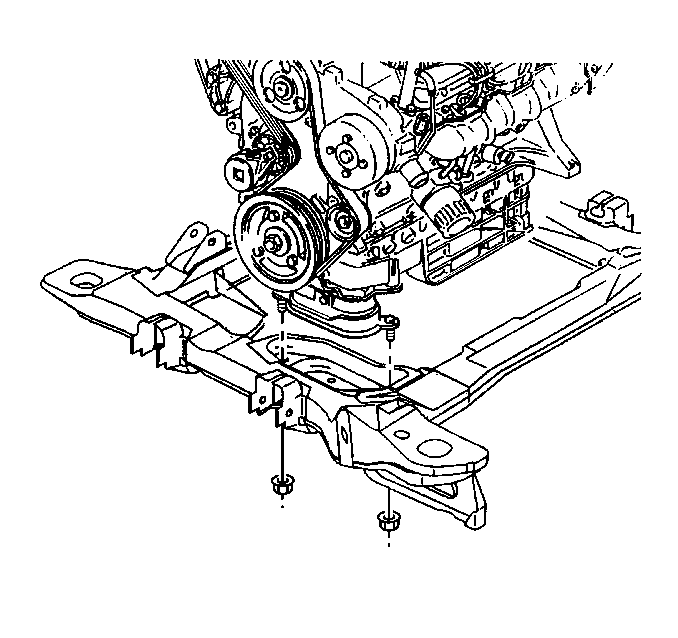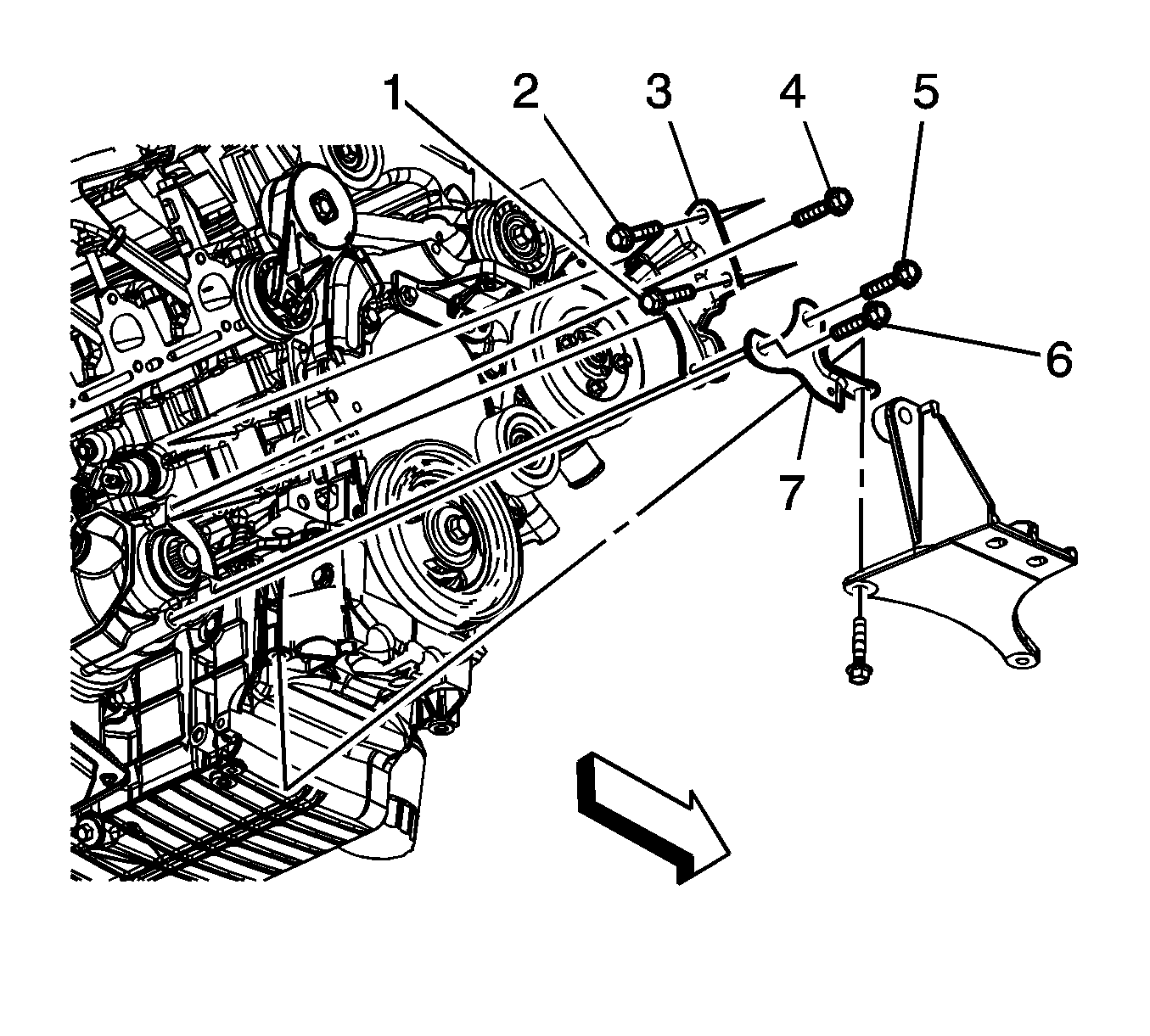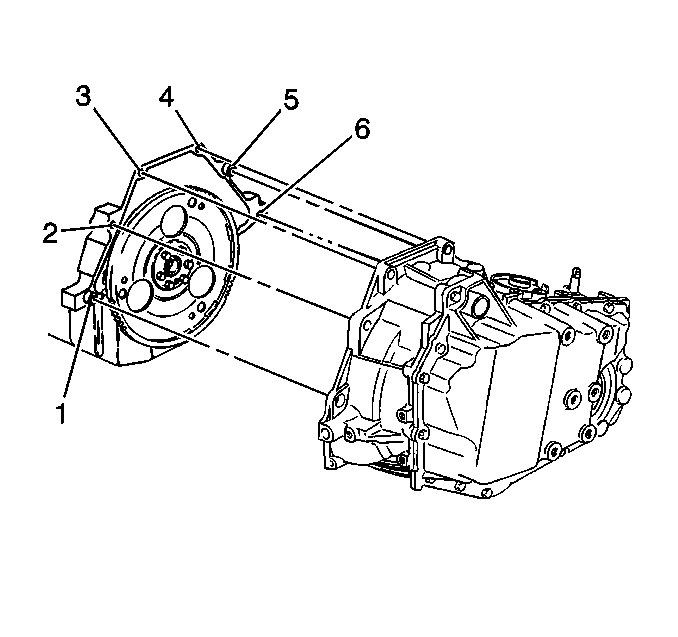Removal Procedure

- Disconnect the negative battery
cable. Refer to
Battery Negative Cable Disconnection and Connection
.
- Drain the cooling system. Refer to
Cooling System Draining and Filling
.
- Drain the engine oil. Refer to
Engine Oil and Oil Filter Replacement
.
- Remove the air cleaner assembly. Refer to
Air Cleaner Assembly Replacement
.
- Remove the hood. Refer to
Hood Replacement
.
- Remove the engine mount strut. Refer to
Engine Mount Strut Replacement
.
- Remove the drive belt. Refer to
Drive Belt Replacement
.
- Disconnect the following electrical connectors:
| • | The camshaft position (CMP) sensor |
| • | The crankshaft position (CKP) sensor |
| • | The heated oxygen sensor (HO2S) |
| • | The manifold absolute pressure (MAP) sensor |
| • | The exhaust gas recirculation (EGR) valve |
| • | The evaporative emission (EVAP) canister purge solenoid |
| • | The electronic throttle control |
| • | The body wiring harness-to-engine harness |
- Raise and support the vehicle. Refer to
Lifting and Jacking the Vehicle
.
- Remove the catalytic converters. Refer to
Catalytic Converter Replacement
.
- Remove the engine wiring harness grounds from the transaxle.
- Remove the engine mount lower nuts.
- Remove the torque converter covers.
- Remove the starter motor. Refer to
Starter Motor Replacement
.
- Remove the air conditioning (A/C) compressor. DO NOT discharge the A/C
system. Support the compressor. Refer to
Air Conditioning Compressor Replacement
.
- Remove the torque converter bolts.

- Remove the engine mount bracket bolts and bracket.

- Remove the engine wiring harness clip from the rear
of the transaxle brace.
- Remove the transaxle brace bolts (5 and 6) and remove the brace (7).

- Remove the lower transaxle-to-engine bolt (6)
and the stud (1).
- Remove the radiator outlet hose from the engine. Refer to
Radiator Outlet Hose Replacement
.
- Lower the vehicle and support the transaxle.
- Remove the heater outlet and inlet hoses from the engine.
- Remove the vacuum hoses from the upper intake manifold.
- Remove the brake booster vacuum hose from the upper intake manifold.
- Remove the fuel lines from the fuel rail. Refer to
Fuel Injection Fuel Rail Assembly Replacement
.
- Remove the radiator inlet hose from the engine. Refer to
Radiator Inlet Hose Replacement
.
- Install the engine lifting device to the engine.
- Remove the upper transaxle-to-engine bolts (3, 4, 5)
and the stud (2).
- Remove the engine from the vehicle.
- Remove the flywheel. Refer to
Engine Flywheel Replacement
.
- Install the engine to the engine stand.
Installation Procedure

- Remove the engine from the engine stand.
- Install the flywheel. Refer to
Engine Flywheel Replacement
.
- Install the engine to the vehicle.
Notice: Refer to Fastener Notice in the Preface section.
- Install the upper transaxle-to-engine bolts (3, 4, 5) and
the stud (2).
Tighten
Tighten the bolts (3, 4, 5)
and the stud (2) to 75 N·m (55 lb ft).
- Remove the engine lifting device.
- Install the radiator inlet hose to the engine. Refer to
Radiator Inlet Hose Replacement
.
- Install the fuel lines to the fuel rail. Refer to
Fuel Injection Fuel Rail Assembly Replacement
.
- Install the brake booster vacuum hose to the upper intake manifold.
- Install the vacuum hoses to the upper intake manifold.
- Install the heater inlet and outlet hoses to the engine.
- Raise the vehicle and remove the transaxle support.
- Install the radiator outlet hose to the engine. Refer to
Radiator Outlet Hose Replacement
.
- Install the lower transaxle-to-engine bolt (6) and the stud (1).
Tighten
Tighten the bolt (6) and the stud (1)
to 75 N·m (55 lb ft).

- Position the transaxle brace (7) to the transaxle
and install the bolts (5 and 6) until snug.
- Install the engine wiring harness clip to the rear of the transaxle brace.

- Position the engine mount bracket to the engine and
install the bolts until snug.
- Tighten the engine mount bracket bolts and transaxle brace bolts.
Tighten
| • | Tighten the engine mount bracket upper bolt to 90 N·m (66 lb ft). |
| • | Tighten the engine mount bracket lower bolts to 50 N·m (37 lb ft). |
| • | Tighten the transaxle brace bolts to 72 N·m (53 lb ft). |
- Install the torque converter bolts.
- Install the A/C compressor. Refer to
Air Conditioning Compressor Replacement
.
- Install the starter motor. Refer to
Starter Motor Replacement
.
- Install the torque converter covers.

- Install the engine mount lower
nuts.
Tighten
Tighten the nuts to 43 N·m (32 lb ft).
- Install the engine wiring harness grounds to the transaxle.
- Install the engine wiring harness ground nut to the transaxle stud.
Tighten
Tighten the nut to 35 N·m (26 lb ft).
- Install the catalytic converters. Refer to
Catalytic Converter Replacement
t.
- Lower the vehicle.
- Connect the following electrical connectors:
| • | The body wiring harness-to-engine harness |
| • | The electronic throttle control |
| • | The EVAP canister purge solenoid |
- Install the drive belt. Refer to
Drive Belt Replacement
.
- Install the engine mount strut. Refer to
Engine Mount Strut Replacement
.
- Install the hood. Refer to
Hood Replacement
in Body Front End.
- Install the air cleaner assembly. Refer to
Air Cleaner Assembly Replacement
.
- Connect the negative battery cable. Refer to
Battery Negative Cable Disconnection and Connection
.
- Fill the crankcase with engine oil. Refer to
Engine Oil and Oil Filter Replacement
.
- Fill cooling system. Refer to
Cooling System Draining and Filling
.
- Perform a CKP system variation learn procedure. Refer to
Crankshaft Position System Variation Learn
.
- Inspect for leaks.








